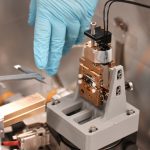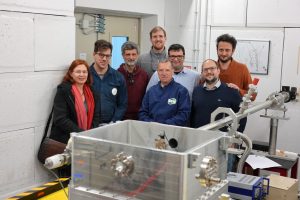 During the week between December 11th and 17th, the SHERPA collaboration conducted a significant experiment in hall 2 of the BTF at LNF. It was a test to explore the possibility of deflecting the trajectory of positrons, the anti-particles of electrons with a positive electric charge, using curved silicon crystals. The phenomenon, known as “channeling”, is well-known and has been used, for example, with high-energy protons at CERN.
During the week between December 11th and 17th, the SHERPA collaboration conducted a significant experiment in hall 2 of the BTF at LNF. It was a test to explore the possibility of deflecting the trajectory of positrons, the anti-particles of electrons with a positive electric charge, using curved silicon crystals. The phenomenon, known as “channeling”, is well-known and has been used, for example, with high-energy protons at CERN.
The possibility to extend this technique to lighter particles at lower energies will simplify and reduce the cost of extraction and manipulation of beams of this kind. This will open up new opportunities not only for fundamental physics experiments but also for applications in technology and medical physics.
SHERPA (Slow High-efficiency Extraction from Ring Positron Accelerator) is a collaboration between researchers from LNF and the INFN section of Rome 1, funded by the INFN’s Fifth Scientific Commission from 2020 to 2022, to conduct an initial feasibility study. Due to the COVID pandemic, the planned activities faced various delays, and only this year was it possible to complete the measurement program.
 Marco Garattini, the project’s P.I., is very proud of the work done: “The channeling of positrons at this energy level had not been observed before. I believe these results represent a significant step forward in the field of accelerator physics. Another source of pride is having achieved this in Frascati, with a group of young and passionate researchers, strongly supported by senior experts of proven value. An important technological aspect was the precision mechanical support to curve the 15 μm thick silicon crystals, produced by the INFN section of Ferrara, controlling their curvature without damaging them. To understand the technical challenge but also the fragility of such crystals, consider that they are less than one-fifth the thickness of a normal photocopy paper!”.
Marco Garattini, the project’s P.I., is very proud of the work done: “The channeling of positrons at this energy level had not been observed before. I believe these results represent a significant step forward in the field of accelerator physics. Another source of pride is having achieved this in Frascati, with a group of young and passionate researchers, strongly supported by senior experts of proven value. An important technological aspect was the precision mechanical support to curve the 15 μm thick silicon crystals, produced by the INFN section of Ferrara, controlling their curvature without damaging them. To understand the technical challenge but also the fragility of such crystals, consider that they are less than one-fifth the thickness of a normal photocopy paper!”.
Building on a project already implemented at the National Laboratories of Legnaro and the INFN section of Ferrara, Tommaso Napolitano, head of the Mechanical Design and Construction Service (SPCM) at LNF, optimized and realized the precision mechanical support.
To characterize the crystal, i.e., its curvature and deflection efficiency, the incident beam must be as point-like and collimated as possible to precisely hit the center of the crystal. In this regard, to reduce the dispersion of incident particles, the joint SHERPA and SPCM team studied and created a 20cm long collimator with an opening of only 0.25mm².
The support with the curved crystal was mounted on a remote handling system capable of micrometric movements and was installed, along with the collimator, inside a vacuum chamber ready to be exposed to the positron beam of the BTF. To measure the angle and efficiency of “channeling,” a silicon pixel detector (TimePix3) was finally placed at a distance of about 3m, to reconstruct the two-dimensional distribution of particles after passing through the crystal.
“Another crucial aspect of the experiment was to precisely align all components of the experimental setup, i.e., the collimator, the crystal, and the pixel detector, to less than a tenth of a millimeter. This goal was achieved thanks to meticulous teamwork by members of SPCM and SHERPA,” comments Tommaso Napolitano.
For its part, the BTF team worked on optimizing the beam: “We had to ensure that the positrons were collimated to the maximum,” explains Luca Foggetta, scientific manager of the BTF. “By adjusting the magnets of the line, we managed to obtain a beam with transverse dimensions of 0.8mm in X and 1.2mm in Y and align it with the small aperture of the SHERPA collimator.”
“The first days of the week were dedicated to aligning the SHERPA apparatus with respect to the beam and defining the best experimental measurement conditions,” says Marco Garattini. “Starting from Friday, the data acquisition campaign ‘searching for channeling’ began, varying the point and angle of incidence of positrons on the crystal.”
Data acquisition then continued successfully throughout the weekend, and now all that remains is to analyze the large amount of collected data to compare it with what MonteCarlo simulations predict.
“I want to thank INFN for the opportunity given to us, the LNF for the great support, and all the members of SHERPA for always believing in us,” Marco Garattini concludes.
 INFN-LNF Laboratori Nazionali di Frascati
INFN-LNF Laboratori Nazionali di Frascati